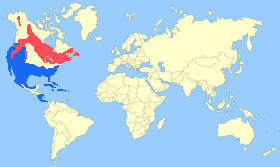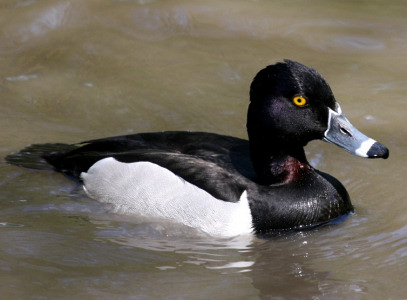Appearance:
Male - The male Ring-necked Duck has a black head and neck with a purple sheen, an inconspicuous cinnamon neck ring, grey-blue beak with a broad white band and black tip, a distinctive white line around the base of the beak, yellow eyes, the upperparts, vent, and tail are black, the flanks and abdomen are whitish-grey, the speculum is silver-grey, and the legs and feet are grey. The male Ring-necked Duck has a similar coloured plumage to its relative, the Tufted Duck.
Female - The female has a pale brown head and body, whitish chin, throat, and around the base of the beak, white stripe behind the eye, white eye-ring, dark brown back, grey beak with subtle white band, and brown eyes.
Eclipse - The male in eclipse has a browner plumage with brown-black head, breast and back. Differs from the female by having bright yellow eyes and no eye-ring.
 |
 |
 |
Compare ducks with similar appearance.
Lesser Scaup, Greater Scaup, and Tufted Duck.
Size: - Typical Adult is about 43cm (17in).
Food: - Aquatic plants, seeds, roots, molluscs, crustaceans, worms, and aquatic insects.
Habitat/Range: - Wooded lakes, ponds, rivers and bays in Canada and northern USA. Winters further south in southern USA, Mexico, Cuba, and Jamaica.

 Breeding Habitat/Resident,
Breeding Habitat/Resident,  Migration or Winter Area.
Migration or Winter Area.Breeding Season: - May to June.
Eggs: - 6 to 14 (creamy-buff colour).
Notes: - The Ring-necked Duck or Ringbill is a small North American diving duck. The cinnamon neck ring is actually quite hard to see but this duck differs from the Tufted Duck by having a white band on its beak and a white line around the base of its beak.
Conservation status (IUCN 3.1):
Least Concern.
Classification: - Family: Anatidae,
Subfamily: Aythyinae, Genus: Aythya.































